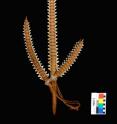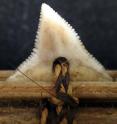Shark tooth weapons reveal missing shark species in Central Pacific islands
Related images
(click to enlarge)
The Gilbert Island reefs in the Central Pacific were once home to two species of sharks not previously reported in historic records or contemporary studies. The species were discovered in a new analysis of weapons made from shark teeth and used by 19th century islanders, reported in a study published April 3 in the open access journal PLOS ONE by Joshua Drew from Columbia University and colleagues from the Field Museum of Natural History. Sharks were culturally important to the Gilbertese Islanders; historic records indicate a complex ritual system surrounding shark fishing and making fishing gear and weapons from shark teeth. For the current study, the researchers analyzed a collection of 120 of these weapons from the Field Museum of Natural History, including some that resemble clubs, daggers, lances, spears and swords. They identified eight species of sharks based on the teeth used in these weapons, two of which have never been reported from these waters, in either historical surveys or contemporary analysis. Both these species are currently common in other areas, so while it is possible that these species may still be living undiscovered in the GIlberts, it is more likely that the local populations have been driven to extinction.
"When we looked we found this shadow biodiversity, hints and whispers of what these reefs used to be like. It's our hope that by understanding how reefs used to look we'll be able to come up with conservation strategies to return them to their former vivid splendor," says Drew.
According to the study, sharks in these waters play important ecological and cultural roles, and understanding the historical ecological conditions of these reefs is an important first step in evaluating conservation efforts.

